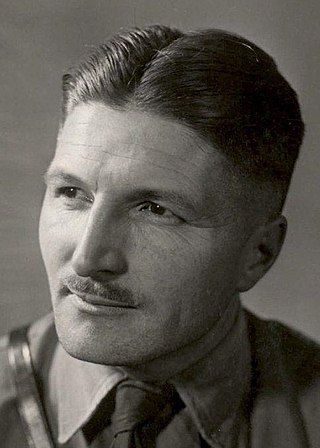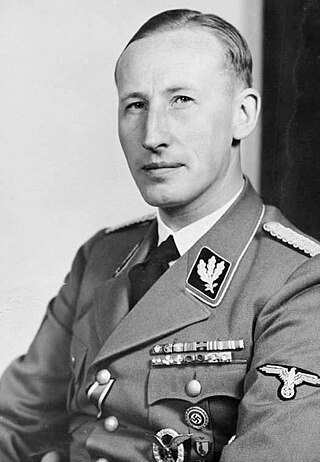阿道夫·希特拉和納粹黨的主要准軍事組織 来自维基百科,自由的百科全书
黨衛隊(德語:Schutzstaffel,發音:[ˈʃʊtsˌʃtafl̩] (ⓘ),簡稱SS),為德國納粹黨內負責監察黨紀及對黨魁個人忠誠、以及執行黨中央(黨魁)決策命令的分部。其前身為希特拉的個人衛隊,於長刀之夜後兼併失勢的衝鋒隊建制而正式成型。
納粹黨執政後,隨着國防軍與司法機構內納粹黨員的人數逐漸增長,納粹黨開始對國防部進行滲透,黨衛隊在國防部與法務部內也成立相關組織,即為負責作戰的武裝黨衛隊和負責掌握司法關押的骷髏總隊,黨憑藉掌握武器與槍逐漸鞏固其政權地位。該組織除對內維護黨紀、對外維護納粹黨統治外,亦執掌對德國國家機構的忠誠審核,整頓國內社會上被其認為反黨反民族的事物,同時監察德國境內各領域的思想綱領等工作外。希特拉藉任命黨衛隊全國領袖兼任德國內政部長以合併黨職與官職,黨衛隊以黨中央機關身份同時執行德國內政部職能,統一指揮黨屬準軍事團體(納粹衝鋒隊)及國家執法機關(蓋世太保),為納粹黨實現黨國一體化最重要的工具。
除上述兩大單位外,因黨衛隊領袖身兼內政部長身份,國家警察(蓋世太保)、國家安全局等國家機構亦一併受其管轄指揮。二戰中後期,由黨衛隊所領導的武裝黨衛隊、骷髏總隊及其他準軍事部隊針對猶太人及少數敵視群體設計並實施了大屠殺。
「Schutz Staffel」直意護衛(Schutz)部隊(Staffel),為納粹黨為保障黨魁阿道夫·希特拉安全,建立的特別保安部門,後延伸發展成以希特拉為核心、海因里希·希姆萊所領導的直屬權力機構。[1]
因分支機構武裝黨衛隊參與直接戰鬥,中文經常將其俗稱黨衛軍,導致混淆。實際上黨衛隊的主要功能仍然是紀律檢察和公共治安。
1925年由納粹黨黨衛衝鋒隊內部所創建。1929年開始由海因里希·希姆萊擔任黨衛隊最高長官開始,該部門迅速擴大權力,以捍衛黨中央領導納粹黨全體的紀律為目的,跨大為以黨首希特拉直接指揮的最高紀律監察機關。1933年納粹黨執政,希特拉就任總理,任命海因里希兼任內政部長,直接實行以黨機關控制德國。隨着《解決人民與國家痛苦的法律》頒佈,進一步推動「黨國一體」納粹黨與政府權力一體化。由黨機關的黨衛隊經其最高領袖身任德國內閣內政部長,納粹黨組織奪取德國行政機關,納粹黨的紀律監察部門替代德國公安警察體制。納粹黨以黨衛隊建立對應德國政府行政部門職權機能的12機能部:
以此黨衛隊所掌握的「治安警察」(刑事警察與蓋世太保)、「秩序警察」(防暴、消防)、保安處(情蒐)、集中營(監禁、處決)4大領域為納粹黨控制德國權力基石。執行監督黨內紀律,確保擁戴納粹黨中央領導的忠誠。打擊任何活躍或潛在國內敵人,摧毀意圖破壞民族團結的反對運動。主導投入社會文化教育,宣揚納粹主義精神和所內涵的民族文化深入人心。以權勢、恐嚇、刻意煽動縱容暴力手段,威脅各領域的言論,達到輿論與媒體的整改至符合納粹黨政策。營運德國內外的滲透組織工作,獲取國家利益與政治穩定情報。負責各地集中營與滅絕營的管理,並至佔領區與戰場前線清洗不符種族政策之原住居民等任務。
除個別部門屬下特殊部隊(「骷髏總隊」、「武裝親衛隊」)成員外,以上納粹黨衛隊全體正式人員,統稱為普通隊員。
第二次世界大戰時期,黨衛隊直接接管德國佔領區的所有警政勤務,貫徹佔領區內綏靖鎮壓、清算反抗、逮捕異議、政治迫害的統治,其部門、成員不一進行成大量的戰爭罪及反人類罪行動。
尤其戰時主導佔領區和軸心各國內的猶太人與吉普賽人的種族奴役、屠殺工作。強制猶太人進入集中營進行無人道的嚴酷勞動生產,以直接處決和間接惡劣環境的手段,造成550萬到600萬名猶太人、22萬人到150萬羅姆人和其他受害者死亡。
德國戰敗後,紐倫堡國際軍事法庭判定其為犯罪組織,使其成為納粹黨最惡名昭彰的機構。僅存的最高級別官員,恩斯特·卡爾滕布倫納在國際法庭中被判反人類罪行成立,執行絞刑。
時至進入21世紀,對未接受審判的逃逸黨衛隊員,其犯罪追溯永不中斷,仍持續發佈追捕。未接受定罪之所有黨衛隊員,一經確認本人死亡,即追判身分為戰爭犯罪者載入史冊,毫無僥倖。

1923年3月,時任納粹黨財務處長兼衝鋒隊幹部的約瑟夫·貝希托爾德與同為衝鋒隊幹部的尤利烏斯·施雷克共同為希特拉另外從衝鋒隊中編制組織專護衛他本人的「儀仗警衛隊」(Stabswache),[2][3][4]該組織於1923年5月改組為「阿道夫·希特拉突擊隊」,由約瑟夫·貝希托爾德擔任總指揮。[4][5][注釈 1]1923年納粹黨為奪取巴伐利亞政權而在巴伐利亞首府幕尼黑市的貝格勃勞凱勒啤酒館發動以衝鋒隊發動武裝奪權的啤酒館政變,阿道夫·希特拉與赫爾曼·戈林和魯道夫·赫斯3人一同率領600名衝鋒隊員衝入佔領貝格勃勞凱勒啤酒館並宣稱成立新巴伐利亞政府,衝鋒隊幹部恩斯特·羅姆率領1,000多名衝鋒隊員佔領巴伐利亞邦邦防軍司令部、廣播電台等重要公共設施。但在納粹黨與其它共同起義的右翼武裝團體(政務官團等)為新政府指揮權爭執不休下,巴伐利亞邦防軍副總司令立即宣佈巴伐利亞邦軍不聽從向被佔領的州軍司令部指揮[6]。
在由同參加政變的德軍退役將將領埃里希·魯登道夫向駐巴伐利亞的德國國家防衛軍第7師團司令奧托·馮·洛索少將說服駐軍加入政變前,洛索已接收到德國國家防衛軍總司令漢斯·馮·塞克特所下達的鎮壓命令。因此在國家防衛軍與巴伐利亞邦防軍的一同保護下,巴伐利亞政府立即發佈全州警急狀態並發佈下令解散納粹黨任何活動,並同時在國家防衛軍、防衛軍軍校生、巴伐利亞邦防軍及警察部隊的合作下,一一將盤距在慕尼黑市內的納粹黨員、衝鋒隊、一同發動起義的各右翼武裝團體成員全部鎮壓逮捕。在此次政變失敗之後,巴伐利亞政府立即下令衝鋒隊和突擊隊全部強制解散[6][7]。
在啤酒館政變時被逮捕判刑的希特拉於1925年出獄後,立即向巴伐利亞邦州長海因里希·黑爾德協商,在保證絕不會再度使用武裝暴動來奪取政權的承諾下,德國政府於1925年2月25日解除納粹黨的非常狀態警戒,納粹黨再度結成。[8]同年4月,約瑟夫·貝希托爾德於啤酒館政變失敗後,逃往奧地利尚未回國,於是希特拉先另行向施雷克下令,重新組織一支在各種集會及平時行動中保護希特拉人身安全的隨扈團,取名為「黨衛隊」,[9][10][11][注釈 2]施雷克擔任隊長,最初由8個人組成,[10]和阿道夫·希特拉突擊隊的差異,是這支新的護衛隊不再由衝鋒隊成員中直接抽調,而是嚴格的從納粹黨員、衝鋒隊員中,選擇沒有任何警察調查記錄、並有兩名以上納粹黨員作為保證人的人選,獨立組成的部隊,奠定了黨衛隊之後精英主義的開端。1925年9月,施雷克再將黨衛隊擴張成為納粹黨每個地方黨部、黨內派系都配置來護衛各黨部幹部、派系領導等納粹黨要的正式編制,使黨衛隊轉成擴張保護全體納粹黨重要幹部人身安全的納粹黨正式隨衛團,施雷克並改組黨衛隊的組織成符合全黨規模的指揮編制體系,該部門首長也甚至稱為「黨衛隊全國領袖」(Reichsführer)。和維護納粹黨平常黨務、政黨活動、納粹黨資產安全的衝鋒隊並立。隔年1926年4月,因幕尼黑事件而流亡奧地利的前阿道夫·希特拉突擊隊隊長約瑟夫·貝希托爾德回國[12][13],施雷克卸任黨衛隊全國領袖,約瑟夫·貝希托爾德交接成為黨衛隊第2任黨衛隊全國領袖。
但7月,衝鋒隊擴充成為一個全國性組織後,藉由在第2次納粹黨代表大會時以黨員支持優勢批鬥貝希托爾德,將黨衛隊納為隸屬衝鋒隊的下屬組織[14][15][16],時任「衝鋒隊最高領袖」的弗朗茨·普費弗·馮·薩洛蒙強硬要求貝希托爾德並卸任黨衛隊全國領袖,轉回衝鋒隊身分[17],因此3月黨衛隊副領袖埃哈德·海登接任貝希托爾德成為第3任黨衛隊全國領袖[17][18][19]。由於弗朗茨的衝鋒隊對黨衛隊下達的黨衛隊規模不可超過衝鋒隊10%的限制,以及埃哈德·海登任黨衛隊全國領袖後在編制限制下大幅強化黨衛隊的精英理念,嚴格要求堅韌的紀律和素質,使其黨衛隊從全盛時的1,000人縮減到280人[17],連執行職務的黨要護衛都有疑慮。因此慘遭弗朗茨的衝鋒隊提出解散黨衛隊,將護衛職權納入衝鋒隊的提案。但埃哈德任命海因里希·希姆萊為他的代理,重新強化黨衛隊的領導和編制,使黨衛隊勉強維持編制。1929年1月6日,埃哈德被弗朗茨告發身穿的制服來自猶太人經營的店製作,在希特拉的授意下辭去黨衛隊全國領袖,由海因里希·希姆萊接任第4任黨衛隊全國領袖[15][16][19][20][21][22][23][24][25]。
因1929年10月24日的經濟大恐慌爆發,讓德國當時社會環境冒出大量失業者,失業勞工因為痛恨執政的基督民主黨,聲稱也是「國家社會主義者」,加入納粹黨擴編中的警衛部隊衝鋒隊和黨衛隊[26]黨衛隊出於嚴謹考選以及被衝鋒隊限制而成長有限,12月底也才成長至2700人。[16][27]。但衝鋒隊寬鬆的管理造成各地衝鋒隊因為過多的人數短時間的加入迅速膨脹,成員素質低下並有眾多工權主義份子混入使其難以控制。開始有眾多的衝鋒隊員在德國各地暴動,自行組織不受黨部管制的政治主張,即使是身為黨魁的希特拉也難以指揮。這對在慕尼黑暴動失敗後,目標是合法取得政權的納粹黨,是很大的形象傷害與政治問題。讓希特拉本人深刻體會到納粹黨必須有自身的警察組織,來確保黨內秩序的必要性,而由原本就是擔任他護衛和具備高度紀律的黨衛隊身任最恰當[16][28]。1930年,希特拉趁德國國會選舉時,以衝鋒隊黨員的素質不佳為由,要求衝鋒隊員從納粹黨的國會議員後補中剔除。並且在11月7日發佈了「黨衛隊最首要的任務就是在黨內執行警察職責」的命令,確立了黨衛隊在黨內具有的警憲權力。弗朗茨為了對此表示大表不滿抗議而辭去衝鋒隊最高領袖職務,衝鋒隊最高領袖開始直接由希特拉擔任,藉此希望擴張黨衛隊的警察權和衝鋒隊掌握。但此舉引發衝鋒隊內的柏林東部領導華瑟·施滕納斯的不滿[29],要求將當時身任納粹黨大管區領袖(大管區為納粹黨地方黨部的管制組織)的約瑟夫·戈培爾解任,但遭黨部拒否,8月30日,維爾特率旗下東柏林衝鋒隊攻擊大管區位於柏林的本部,時任柏林黨衛隊領導的庫爾特·達呂格(前柏林衝鋒隊領袖,1930年7月加入黨衛隊,因為與希姆萊之間的協議,柏林的黨衛隊由他獨立指揮)率隊來抵抗卻失敗,最後是由普魯士邦正規政治警察介入才得以鎮壓庫爾特的衝鋒隊。
為此當時希特拉認為必要有監視納粹黨內的反抗勢力的監視組織和整頓黨內政風,因此授權希姆萊開始改組黨衛隊的組織,並在1930年11月7日正式下達納粹黨的命令,正式將黨衛隊成為納粹黨內的警察組織,賦予負責警備納粹黨黨部褐色之家的總警備,負責「防止共產份子和任何干擾黨的活動」任務,用於監控黨內、逮捕不服從黨路線份子。並自此從衝鋒隊獨立,必要時衝鋒隊必須服從於黨衛隊的指揮。

1931年6月,從海軍失業的萊因哈德·海德里希加入黨衛隊,成為希姆萊和他的得力幹將,在1932年,希姆萊給了萊茵哈德·海德里希一個任務,要求在黨衛隊內建立一個高水準的機構,即「黨衛隊情報科」。1932年,黨衛隊情報科改組為保安處,萊因哈德·海德里希讓保安處在各地黨部內都設有支部和眾多活動人員。讓保安處使它當時不只成為了納粹黨內各黨部的監控機關,還掌握德國境內所有不同政黨政敵、關員與各地情資的龐大情報機構[30][31]。使之納粹黨之所能有效從政治活動上取得優勢、掌握及時局勢反應、操作輿論情報,最終在合法選舉內擊敗反對政黨取得優勢席次的最強利器。保安處規模與效率大到連衝鋒隊內也意圖效仿而成立自身的情報課。 因1933年1月30日希特拉就任總理,納粹黨幹部開始到各州政府擔任要職。於3月9日納粹黨國會議員弗朗茨·里特率領衝鋒隊和黨衛隊鎮壓反抗納粹黨政權的巴格利亞政府,並在之後擔任慕尼黑警察首長、而海德里希就任慕尼黑警察政治局長。4月,希姆萊擔任巴格利亞邦警察首長、海德里希就任巴格利亞邦警察政治局長。另一方面柏林黨衛隊領袖庫爾特擔任就任普魯士邦總理的戈林旗下的特別警察委員,以警察中將的身分掌控普魯士邦警察權力。2月22日,戈林把25,000名衝鋒隊員、1萬5,000名黨衛隊員,編制為普魯士邦「補助警察」以執行警務工作,由身為特別警察委員的黨衛隊領袖庫爾特指揮。最後希姆萊就任德國的全國警察首長一職,黨衛隊實質上吸收了德國的警察組織。同時柏林大本營警衛隊成立,納粹黨在慕尼黑、漢堡及德累斯頓等大都市成立了政治警備隊,作為其在國內執行政治任務的部隊。這些部隊也就是日後特別機動黨衛隊(SS-Verfügungstruppe,縮寫:SSVT)。1934年,納粹黨藉國會縱火案專政後,納粹黨衝鋒隊迅速擴張到400萬人(警備人員350萬,武裝人員50萬),成為納粹黨滲透德國各地的主要工具。但也因數量過度龐大被暱稱為「第2個國防軍」,甚至衝鋒隊中醞釀要解體國防軍由衝鋒隊取代的聲浪不斷提高。這嚴重傷及執政後納粹黨與國防軍之間的政治互信,因此希姆萊決議於1934年6月30日大肆逮捕衝鋒隊內的反抗勢力,即長刀之夜。此後黨衛隊完全凌駕於衝鋒隊之上,並取代衝鋒隊成為納粹黨主要政治行動組織(但衝鋒隊仍是納粹黨人數最多的組織)[32]。同年,希特拉賦予了黨衛隊管理所有集中營的權力。1937年希特拉設置「黨衛隊以及警察高級領袖」(Höhere SS und Polizeiführer、簡稱HSSPF)將黨衛隊與警察在制度上直接合併[33]。1939年,為了避免黨衛隊保安部與德國執掌國家安全的保安警察權限重疊,黨衛隊成立「德國中央保安局」將德國警政的秘密警察(即蓋世太保)刑事警察局與黨衛隊保安部都總合旗下。

國防軍因疑慮黨衛隊成為另一個衝鋒隊,時任國防部長維爾納·馮·勃洛姆堡計劃應將多個納粹準軍事組織與黨衛隊特遣隊統編管制,因此藉由協助黨衛隊成立3個團規模的武裝部隊,每個團皆下轄3個營、1個摩托化步兵連及1個迫擊炮連;其成員均由已於國家勞役團服役完畢的志願者組成,即黨衛隊特別機動部隊。由國防軍中將保羅·豪塞爾退役後出任特別機動部隊督察,並創建黨衛隊軍官學校,特別機動部隊仰賴國防軍提供武器裝備與軍事訓練,嚴格管制對黨衛隊武裝士兵數目的徵募系統,從招募到訓練都由國防軍掌握,使國防軍的影響力滲透約束控制黨衛隊。1937年10月,黨衛隊所自組的邊防部隊被國防軍勒令解散,[34]直至1939年5月時國防軍對黨衛隊特別機動部隊「德意志旗隊」的演習測考感到非常滿意,計劃將其建制擴編為一個正式的師。慮及黨衛隊特別行動隊未配備重裝備及火炮,在希特拉於波蘭作戰前夕,黨衛隊特別行動隊的炮兵團緊急成立,黨衛隊特別行動隊遂被正式核准成為一個員額不到兩萬人的師。1939年末,在包含由警察組成的警察師和骷髏總隊組成的骷髏師後,黨衛隊特別機動部隊達到56,000人的規模[35]。1939年11月末,為了準備執行黃色作戰,國防軍核准黨衛隊成立獨自的軍事指揮體制,即黨衛隊作戰部,黨衛隊特別機動部隊正式改名為武裝黨衛隊,其他的非軍職的稱為「一般黨衛隊」。
希特拉自殺身亡後,卡爾·鄧尼茨就任德國總統,新政府最初的幾項舉動就包括取締黨衛隊。在希特拉自殺前不久,黨衛隊組織開始變得渙散而群龍無首了。黨衛隊的一些高級將領,包括希姆萊本人,都被希特拉公開指責為叛徒。因為希特拉相信這些黨衛隊已經開始和盟軍談判投降事宜了。值得一提的是,在戰爭的最後幾個月內,由於條件惡劣,大量的黨衛隊員開始開小差,逃離部隊。他們有的來自管理集中營的部隊,有的來自安全部門,例如安全部和蓋世太保。他們這樣做,是因為他們清楚地看到了戰爭即將以失敗告終的事實。他們寧願被德國人當作擅離職守的逃兵抓起來,也不願意被當作戰犯而遭到盟軍逮捕。
1946年9月30日,紐倫堡軍事法庭的法官對黨衛隊組織作了判決,宣佈它是一個犯罪組織。法官們強調,「黨衛隊這個組織的目的是罪惡的,包括迫害、滅絕猶太人,將他們殘忍地殺害於集中營中;毫無節制地強迫被佔領區人民勞動,奴役他們;虐待和虐殺戰俘」。
依據西蒙·維森塔爾的陳述,一些黨衛隊的軍官在戰爭即將結束的時候逃亡到了阿根廷,並在布宜諾斯艾利斯建立一個納粹逃亡組織,代號為ODESSA(「前黨衛隊成員組織」德文Organisation der Ehemaligen SS Angehörigen的縮寫)。他們和德國、瑞士、意大利、梵蒂岡、西班牙的一些宗教勢力,甚至是羅馬教廷有聯繫。據說ODESSA曾經幫助阿道夫·艾希曼、約瑟夫·門格勒、埃里希·普里克等,還有其他許多戰犯在拉丁美洲找到了庇護所。但是一些史學家認為有關納粹分子逃亡拉丁美洲的故事是被人為地誇大了。
現在,有一些新納粹組織發表聲明,他們應該被視為黨衛隊這一組織的發展和繼續。但是還沒有一個新納粹組織被公認為是黨衛隊的延續,它們的組織通常比較鬆散,僅有一些不成系統的章程。
納粹黨黨衛隊的指揮體系共分成12個「本部」來管理,12個本部全向希姆萊負責。
黨衛隊的階級體系是獨特的,它們並未照搬德國國防軍的軍銜體系,而是沿用了當年衝鋒隊的編制。
Seamless Wikipedia browsing. On steroids.